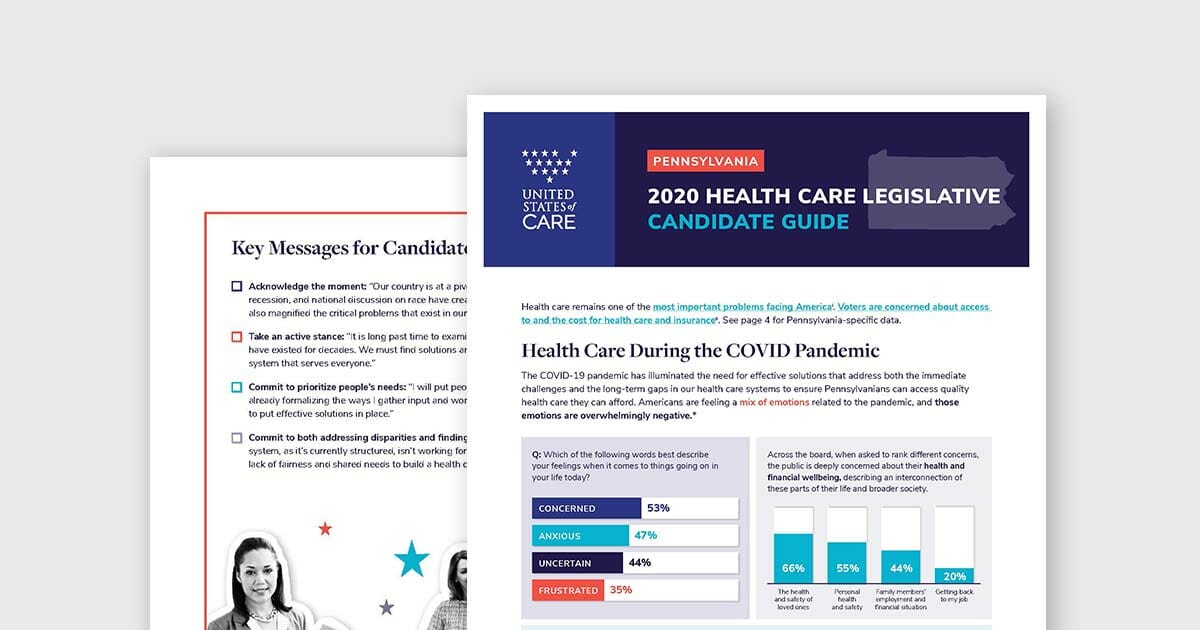Resources, State Efforts
Pennsylvania 2020 Health Care Legislative Guide

Health care access and cost remains one of the most important problems facing America.
- Pennsylvania has the twelfth-lowest uninsured rate in the United States (6% in 2018).
- Pennsylvania’s unemployment rate jumped from 5.8% in March to 16.1% in April on a seasonally adjusted basis. In June 2020 unemployment was 13%, which likely has severed tens of thousands of Pennsylvanians from their employer sponsored insurance.
- Between March and April 2020, nearly 50,000 people enrolled in Pennsylvania’s Medicaid program; this is five times greater than enrollment between March and April 2019.
- As of June 30, 2020, a disproportionate number of those infected (34%) and those dying (29%) in Pennsylvania are Black, Indigenous, and people of color, who make up only 19% of the state’s population.
- Access to health care in rural areas has only become more challenging during the pandemic and will likely have lasting impacts on rural communities. Rural hospitals in Pennsylvania are buckling under the dual financial burdens of preparing for potential COVID spikes and decreased utilization in non-COVID services.
- Seniors are at greatest risk. As of June 30th, over 90% of COVID deaths in Pennsylvania were among patients aged 60 or older.
- In April 2020, the state’s independent fiscal office projected a budget shortfall of $3.7 billion through the end of the fiscal year 2020-21.
The COVID-19 pandemic has illuminated the need for practical solutions that address both the immediate challenges and the long-term gaps in our health care systems to ensure Pennsylvanians can access quality health care they can afford.
Key Messages for Candidates:
- Acknowledge the moment: “Our country is at a pivotal moment. The pandemic, economic recession, and national discussion on race have created a renewed call for action. They have also magnified the critical problems that exist in our health care system.”
- Take an active stance: “It is long past time to examine our systems and address gaps that have existed for decades. We must find solutions and common ground to build a health care system that serves everyone.”
- Commit to prioritizing people’s needs: “I will put people’s health care needs first and I’m already formalizing the ways I gather input and work with community and business leaders to put effective solutions in place.”
- Commit to addressing disparities and finding common ground: “The health care system, as it’s currently structured, isn’t working for far too many. I will work to address the lack of fairness and shared needs to build a health care system that works for all of us.”
Health Care During the COVID Pandemic
The COVID-19 pandemic has illuminated the need for effective solutions that address both the immediate challenges and the long-term gaps in our health care systems to ensure people can access quality health care they can afford. In the wake of COVID, policymakers have a critical opportunity to enact solutions to meet their constituents’ short- and long-term health care needs. The 2020 Health Care Legislative Candidate Guide provides candidates with public opinion data, state-specific health care information, key messages and ideas for your health care platform.
For more information or to seek assistance, contact USofCare at Help@USofCare.org.